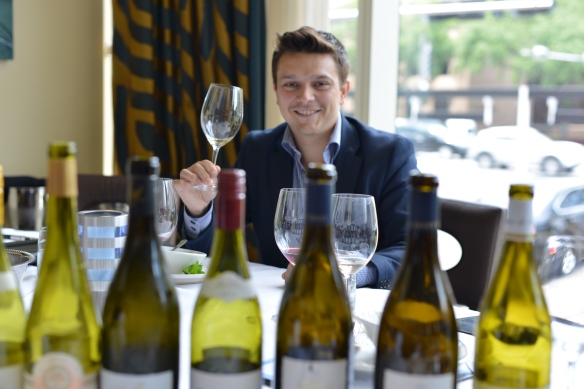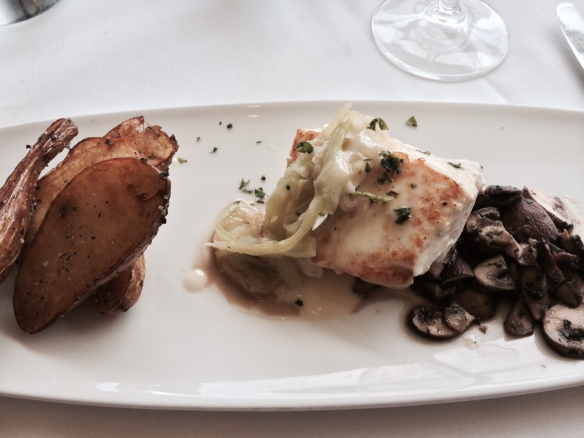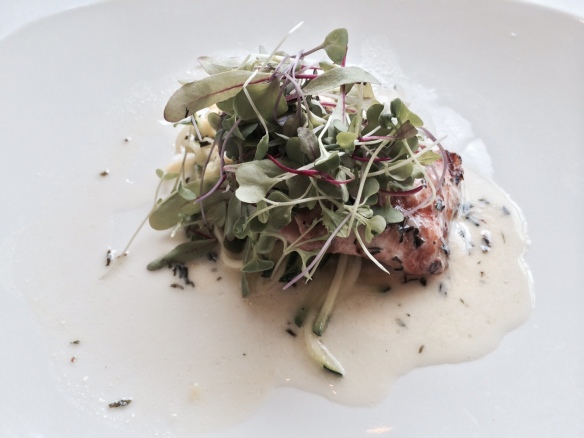I like to talk about wine with people who share my passion for it. We open bottles, we trade stories about travel and soil types, terroir and residual sugar, and we talk of taste and food and restaurants. We recommend wines to one another, we drink, and we learn a lot.
In Wine Talk, I introduce you to friends, acquaintances, and people I meet as I make my way around the world, individuals who love wine as much as I do, who live to taste, who farm and make wine. You’ll appreciate their insight, and I hope you’ll learn something from them as well.
Nick Goldschmidt has a way with wine, and with words. The native New Zealander is gregarious and he’s passionate about his craft. The man is a walking, breathing repository of viticultural knowledge, lore and history.
He’s plied his trade for decades now, in many regions, and the wineries for which he’s worked and consulted are too numerous to mention in this space, but here are a few names: Atlas Peak, Buena Vista, Simi Winery, Clos du Bois, Gary Farrell, and William Hill. Not to mention his own Goldschmidt Vineyards, which was established in 1998.
Goldschmidt’s career officially began in 1982, when he took a research position at New Zealand’s Lincoln University. He graduated from that institution with a degree in horticulture, and did postgraduate work in viticulture and oenology at the Wagga Wagga campus of Charles Stuart University, also in his homeland, and then at Adelaide University, in South Australia, where he was enrolled in the Hickinbotham Roseworthy Wine Science program.
I’ve long known of Goldschmidt, and have enjoyed his wines over the years. When I was contacted recently about Merlot Month and saw that he was one of the participating winemakers this year, I knew I wanted to feature him in Wine Talk. (October is Merlot Month, and PaperCity’s The Pour series will have more about that, so stay tuned, and in the meanwhile, drink more Merlot.)
Goldschmidt and his wife and business partner, Yolyn, have called Healdsburg, California home since 1990, and his passion is now a family affair. In fact, one of the wines I tasted in preparation for Merlot Month was the 2019 Chelsea Goldschmidt Guidestone Rise Merlot (Alexander Valley AVSA). There are five Goldschmidt children, and Chelsea is one of them (the names Hilary and Katherine also grace Goldschmidt labels).
Let’s see what the winemaker has to say.
James Brock: How has COVID-19 changed your work and life?
Nick Goldschmidt: I have a theory that the average white guy lives to 85 and I am 59, so I have 25 years left to live. Twenty five by 365 days is 9,125 bottles of wine to drink. If I drink one bad bottle of wine, that is like throwing a good one against the wall.
I had a dream COVID, as four of our five children moved home. What other time in my life would I have adult children living with me? It was truly an amazing experience.
As a result of the additional people in the house, my wine cellar has been severely depleted and I’ll be closer to 10,000 bottles by the time I pass. The second thing I learned was that my children were asking, “OK, if we are drinking five bottles of wine tonight, which ones are they? We need to start drinking them in reverse order.” This also made sense, so we drank the best wines first. Great idea to finish the evening with a white. Fresh and with good acidity like we now do at wine judgings.
From a professional aspect, I was actually in Chile when COVID hit so I saw the implications of trying to harvest and make wine with all these severe restrictions in place. This meant I knew how hard it would be when I was scheduled to do this in California six months later. I’ve also seen today countries on a slower route to recovery and some that are much faster in terms of vaccinations. This means each country has its own set of rules, not only in terms of getting in, but how it is to work.
For instance, without foreign workers it has been very hard to pick grapes in New Zealand, which I think has been the hardest hit. Getting around Chile takes many special passes each day, which requires getting online before I head off each morning. Then Argentina has been impossible to get into. Canada has also been difficult, but is opening up now. So yes, consulting has been a challenge.
We have also seen difficulty with shipping and trucking. Of course, containers from New Zealand are taking months just to book. But also getting rebar for a planting job I am doing on the Staircase Vineyard has been ridiculous. We ordered in November and finally got it in June.
As a result I think in some strange way that COVID has been good for me in terms of both my personal and professional life. I am much closer to all clients I’ve been in touch with during this time.
JB: Tell us about three wines you think are drinking well at the moment. What makes them worthwhile? How about a food pairing for each one?
NG: I have started drinking what I preach. By that I mean I often talk about wines holding up over time primarily focusing on color and no “crusty deposit on the shoulder of the bottle”. As wines age, they move from purple to red to brown to orange, and I’ve always explained how I get my wines to only go purple and eventually to red. I learned many years ago how to slow the ageing beyond that.
So I started drinking older wines. For example, Goldschmidt Yoeman, which is the first wine that we made, in 1999. I have been drinking the 2001, marking 20 years for this particular wine. Remarkably, it has remained in a purple color with great liveliness, and it still has a fine freshness. No crust. Tannins are of course integrated and possess far more silky complexity than when released.
The second one I’ve been drinking a lot of is Singing Tree Chardonnay. We have been making this wine for a while now. It is from a field selection (no clone) and has a more lively mouthfeel on release and so really helps with its ageing. I have been drinking the 2014 and 2016, which really stayed alive. Both good vintages, of course. I think we have achieved what we set out to do, which is to make a wine with tension and liveliness without the high alcohol.
The reason for tasting is as I look back I wondered if I should add more weight to this wine like we did at Simi. I am carefully analyzing people around me and what their perception of the wine is. Do I make a change, or do I stay the course? So far, stay the course, but I do like analyzing over time. Thinking to how we farmed then and now and how our palates also change.
I don’t often drink wines from wineries for whom I consult, but as of late, based on amazing reviews, I’ve been trying Chadwick Cabernet in the Maipo Valley Chile. This wine has had two 100-point scores and I’ve really focused on those and the vintages around them. To me, it is not about the wine itself but a memory of the vintage. With the memory of the vintage comes my memory of the people who lead the winery and make the wine. I spend three months per year in Chile and have done so for almost 30 years now, so I know the area and the vineyard well. Chadwick 2017 is so far my favorite.

JB: If cost was no consideration, tell us the one bottle you would add to your personal collection, and why.
NG: If cost was no consideration and it was something I could do each day, I would probably choose Vega Sicilia Unico, because it was one of the first great wines that, when I drink it, I drink with the memory of whom I was with, where and when. Even better would be that I would drink it in Spain in the DO of Ribera del Duero (Denominación de Origen).
I worked in the area when I was consulting with Tarsus. This was when I was the chief winemaker at Allied Domecq and so have many great memories of the region and the winemakers as well.

JB: What is your favorite grape variety, and why?
NG: Cabernet, of course. It is so specific to its surroundings. I’m originally from New Zealand, and it is very hard to make there, so having lived in Napa and Sonoma for the past 30 years, I have learned a lot about it. I also see it in Maipo, Mendoza and Okanagan, all places I work. It comes in so many shapes and sizes. The future for me, though, is making these wines under 14 percent alcohol. We are doing it already in some appellations, but will it have respect if it is done in Napa?
It has the power and the weight, but it is a spicy variety, and too often at high alcohol they finish sweet. I really do not like the term “Napa Style,” which is used around the world. We need to get away from that.
JB: How about one bottle that our readers should buy now to cellar for 10 years, to celebrate a birth, anniversary, or other red-letter day?
NG: I always find these questions very difficult to answer. I always wondered why we sell wine by the individual bottle and in 12 packs. Is it because we are supposed to drink one bottle per year, or 12 bottles per year? I’m never quite sure. Let’s say it’s 12 bottles per year. Drink one a month and then you choose the best month of your memory when the wine tasted best.
I think the wine that will taste best is always the one that was drunk in one of the happiest moments. Therefore, choosing a wine for an anniversary or another great celebration in your life has to come with some extra effort. I would choose Goldschmidt Game Ranch Oakville. It is a fairly rare wine of limited release, and a bottle can add to the special occasion and hopefully the happy memories that will go with it.
JB: Where is your go-to place when you want to have a glass or bottle (outside of your home and workplace)?
NG: My children will tell you my happy place is down on the Dry Creek river with a bottle of Boulder Bank Marlborough Sauvignon Blanc. I built a table down there many, many years ago and each Sunday night the family gathers at it. We cook over an open fire away from the Internet but with many bottles of wine and lots of great food. We are very fortunate to live in the Dry Creek Valley, and in particular on the Dry Creek River itself.
JB: If there was one thing you wish everyone would keep in mind when buying and drinking wine, what is it?
NG: I always wish people would keep in mind that wine is a living, breathing, evolving product, and it is of the earth. It is not like making beer or spirits where the goal is to make an amazing product but make it the same every day.
Wine is completely different because the vintage itself tells a story about the weather, the people, the soil and the culture, which is one part. You need to travel to the wine regions, getting to know the places. Doing so gives one great reference for when you are back home and assessing and enjoying the wines.
The second part is where you choose to drink the wine. When I go to a restaurant I always choose something that I cannot pronounce on the menu and the wine generally that I’ve never heard of before. Going out for dinner drinking wine with food is a memory and an experience. Don’t drink badge brands. This is the time to try something different, take a risk.
JB: What is your “wine eureka moment,” the incident/taste/encounter that put you and wine on an intimate plane forever?
NG: For me it was a combination of processes. When I worked in the vineyards at Lincoln College in New Zealand I pruned the vines without actually knowing what wine was about. Then during the summer we picked the grapes and made the wine and then I drank the wine. For me, growing crops is fascinating, but to have it turn into something even cooler is amazing. This particular crop turns into a food product that is unique and different and truly represents where it comes from. There’s absolutely nothing like wine.
JB: What has been the strangest moment or incident involving wine that you have experienced in your career thus far?
NG: I don’t really have any strange moments, but I do have situations in which I suddenly had an “aha” moment.
One of the first ones was when I was making wine in Portugal for LVMH. The company owned Roses, a Port house, at the time. When you’re in Portugal with winemakers you pretty much have three ports — for lunch, breakfast and dinner — so after being there for three days I asked a winemaker if I could have a glass of white wine. He said, we don’t make white wine in Portugal.

But the young lady in the restaurant said, don’t worry I’ll bring you a glass. She filled the glass up to the rim. It was 120 Fahrenheit outside and we were eating barnacles, of which you need three for a mouthful. The condensation was flowing off the glass of wine and it looked so tasty. I took a deep gulp. But when I drank it my whole mouth puckered. It had so much CO2 and acidity in it, and my immediate reaction was, what the heck was that?
The enamel on my teeth was gone, the roof of my mouth was gone, and I had this whole unctuous acidic taste. I asked what it was and the winemaker said it was a Vinho Verde. Well, I didn’t know what Vinho Verde was. I didn’t even know it was a region. I also thought it was CO2, but actually it was minerality. But I always remember that experience. This wine either making me hungry or thirsty and I couldn’t quite work it out. That is sensation I’ve always remembered.
JB: Your favorite wine reference in a work of literature?
NG: I have many, but they are all about winemaking, specifically production. This is one of my favorites: “Drinking a bad bottle of wine is like throwing a good one against the wall”.
Want more wine? Read on:
A Loire Favorite, and Other Tasting Notes
Caitlin Cutler Really Likes Malvasia
Dan Petroski on Soil and J. Alfred Prufrock
A Canadian Makes Good in Mendocino
Bouchaine’s Chris Kajani Tackles the Challenges of a Pandemic
A Bosnian Winemaker Finds a Home in the Sta. Rita Hills AVA
From a Michigan Backyard Vineyard to Sonoma
Paul Hobbs Knew She Had Talent
Ian Cauble: From ‘Somm’ to SommSelect
Eric Sigmund is High on Texas Wine
Jeff Cole, Sullivan Estate’s Winemaker
Jon McPherson Talks Tokay and His Mentor Father
Two Reds From Chile
An Italian Chardonnay From the Cesare Stable
Mi Sueño’s 2016 Napa Valley Syrah
Joshua Maloney on Riesling and Manfred Krankl
Brothers in Wine
Two Bottles From Priest Ranch
A Derby Day Cocktail
Nate Klostermann is Making Some Great Sparkling Wines in Oregon
Matt Dees and the Electric Acidity of Sta. Rita Hills Chardonnay
Baudelaire, Pinot Noir, and Rosé: Kathleen Inman’s Passions
Colombia, France, and California: This Winemaker is a Complex Woman
Michael Kennedy Talks Sailing and Zinfandel
Spain Opened the World of Wine for Spottswoode’s Aron Weinkauf
Alta Colina’s Molly Lonborg Wants a Bottle of Château Rayas
Mumm Napa’s Tami Lotz Talks Wine and Oysters
James MacPhail on Pinot Noir, White Burgundy, and Russell Crowe
A Very Proper Sparkling Wine
Talking With David Ramey
A Merlot That Your Snob Friend Will Love
French Couple Make a Sauvignon Blanc in California
A Perfect Afternoon Chardonnay
Terry Theise Talks Reisling
A New Wine Wonderland
Paris Wine Goddess Tells All
Rice Village Wine Bar Has a Cleveland Touch
A Texas White Blend for Your Table
A Pinot Noir Full of Flavor
This Pinot Gris From Oregon Pairs Well With Cheese
Willamette, Dammit!
A Value Rioja
Drink Pink!
Underbelly Veteran Goes for Grenache
A Man of Letters and Wine
Ms. Champagne Wants a Nebuchadnezzar
The Wine Artist Goes for Chardonnay
This American Loves Spain and Its Wines
Houston’s Wine Whisperer Has a Soft Touch
Blackberry Farm’s Somm Pours in Splendor
Mr. Pinot Noir: Donald Patz of Patz & Hall
A Cork Dork Wants to Spend More Time in Tuscany
Sommelier Turned Restaurateur Daringly Goes Greek
Texas Master Sommelier Debunks Wine Geeks
A Bottle From Gigondas Changed This Houston Man’s Life
Oil Man Falls in Love, and the Rest is Good-Taste History
Ryan Cooper of Camerata is a Riesling Man
Mixing It Up With Jeremy Parzen, an Ambassador of Italy
Sommelier at One of Houston’s Top Wine Bars Loves Underdogs









































Recent Comments